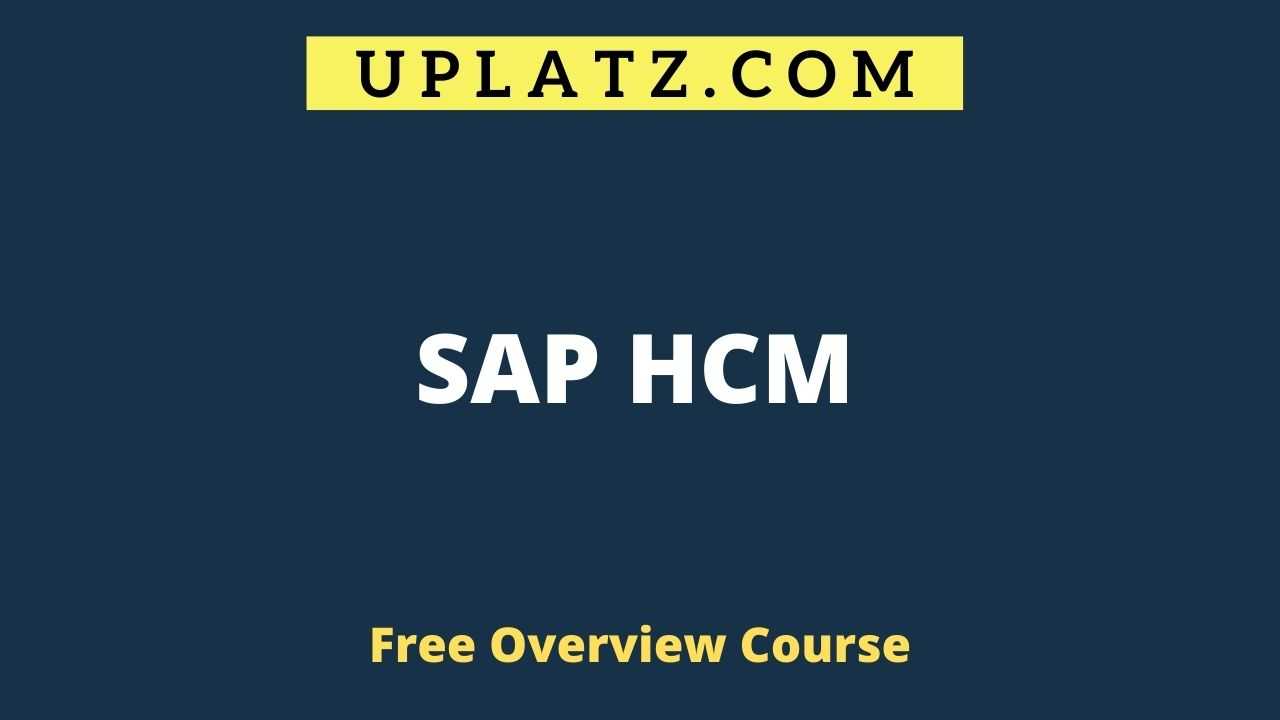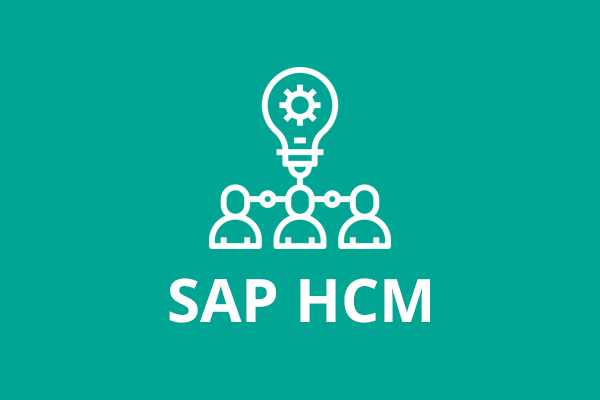Overview Course - SAP HCM
You’ll learn about SAP HCM course which is designed to cover all the concepts of SAP HR and the elements of SAP HR. View Course Curriculum
Price Match Guarantee
Full Lifetime Access
Access on any Device
Technical Support
Secure Checkout
Course Completion Certificate
View Course Curriculum
Price Match Guarantee
Full Lifetime Access
Access on any Device
Technical Support
Secure Checkout
Course Completion Certificate
 87% Started a new career
Enroll Now
87% Started a new career
Enroll Now
-
 88% Got a pay increase and promotion
88% Got a pay increase and promotion
Students also bought -
-

- SAP HCM (basic to advanced)
- 25 Hours
- GBP 12
- 2185 Learners
-

- SAP HCM (Human Capital Management)
- 20 Hours
- GBP 12
- 2492 Learners
-

- SAP HCM Payroll
- 4 Hours
- GBP 12
- 121 Learners

This is an overview course on SAP HCM while the complete detailed-level SAP HCM course is available at -
https://training.uplatz.com/online-it-course.php?id=sap-hcm-human-capital-management-15
SAP HCM is one of the vital modules in SAP that plays an important role in building an organized management in company. SAP HCM consultants are some of the most demanded professionals in the global market. It is suitable to gain an overview of SAP basics, SAP Net Weaver and SAP solution manager prior to starting with SAP HCM module. Students need to fulfil certain eligibility criteria to become eligible for opting SAP HCM exam.
SAP HCM is one of the most important processes in company across industries. The general idea on HR is related only to recruiting. But HR is much beyond just recruiting. In an company, HR not just hires employees but separate employees based on various factors such as department level, payment days, payment details, designations and more. Besides, various other works like promotions, employee engagement and team motivation tasks are taken care of by the HR. These works might sound very simple; however, working out all these for people of an whole organization is not an easy work at all. To streamline all such HR processes, SAP ERP operations are widely used. SAP HCM ERP is one of the most flexible software for HR processes widely used across industries.
The eligibility basis is determined based on the SAP AG Education Policies and vary from continent to continent. In general, students should have a year or two years of experience in SAP HCM module before attempting the exam. Let’s have an overview on the SAP Human Capital Management (HCM) module.
Course/Topic - SAP HCM overview - all lectures
-
Lecture 1 - Introduction to HCM
-
Lecture 2 - Organisation Management - Part 1
The objective of this SAP Human Capital Management (SAP HCM) course is to provide learners with a thorough understanding of SAP HCM’s functionalities and its role in managing human resources within an organization. Participants will gain practical experience with key modules including Personnel Administration, Organizational Management, Time Management, and Payroll. The course covers essential topics such as employee lifecycle management, data integration, and HR reporting. By the end of the course, learners will be equipped to effectively implement and utilize SAP HCM to streamline HR processes, enhance employee management, and support strategic human resource planning and administration.
-Key Course Objectives-
Understand the role of SAP HCM in managing human resources and personnel processes within organizations.
Learn about the architecture and components of SAP HCM, including organizational management, personnel administration, and time management.
Gain proficiency in configuring SAP HCM for employee master data management, including hiring, transfers, promotions, and terminations.
Explore SAP HCM's capabilities for payroll processing, benefits administration, and compensation management.
Understand SAP HCM's integration with other SAP modules such as SAP SuccessFactors and SAP ERP systems.
Learn about talent management functionalities in SAP HCM, including performance management, learning and development, and career planning.
Develop skills in using SAP HCM for workforce analytics, workforce planning, and strategic HR reporting.
Discuss best practices for implementing and maintaining SAP HCM, including system configuration, data migration, and compliance.
Analyze real-world case studies and examples of successful SAP HCM implementations across various industries.
Prepare for potential SAP HCM certification exams (if applicable) by covering exam topics and practice scenarios.
These objectives aim to provide participants with a comprehensive understanding of SAP HCM and practical skills to effectively manage human capital and HR processes using SAP's integrated solution.
SAP HR-HCM Contents
1.Introduction to ERP and SAP
a. History of SAP
b. ERP Need and Advantages
c. Overview of Centralized and Decentralized System
d. Organizational structure in HR
e. Technology
f. Implementation Tools (Asap and Solution Manager)
g. System Landscape in 3 Tier Architecture
h. Roles and Responsibilities of a Consultant
i. Types of Projects
j. Change Transport System
k. Gap Analysis
l. Versions
m. Architecture in SAP HRM
n. Create Folders, Transaction codes
o. Adding to Favorites
p. Creating Users and Roles
2. Organizational Management in HR
a. Organizational Management Introduction
b. Structure in SAP HCM
c. Objects
d. Relationships
e. Structure of Relationships
f. Syntax of Relationship
g. Methods of Creating Org. Structure (Org.Units, Job, Position)
h. Simple Maintenance
3. Expert Mode
a. Organizational and Staffing
b. Editing of Objects and Relationships
c. Validity Period
d. Info type in OM
e. Plan version Definition and setting of New plan Versions
f. Custom Objects Number Ranges
g. Features in OM
h. Evaluation Paths
i. Integration Switches
j. Integration Reports between Organizational Management to Personnel Management OM to PA/PD
k. Reports in OM
4. Personnel Administration:
a. Structure in SAP HCM
b. Master Data Definition and its use in SAP HCM
c. Enterprise structure- Definition and Assignment
d. Company, Company Code
e. Personnel Area, Personnel Sub Area
f. Personnel structure Definition and Assignment
g. Employee Group
h. Employee Subgroup
i. Payroll Area and Control Record (with Retroactive Accounting Period)
j. Employee Attributes
5.Info types and Sub types
a. Features in SAP HCM importance and various feature configurations according to requirement
b. Number Ranges for Employee personnel numbers-internal & External with Feature Setup
c. Customizing User Procedures:
d. Configuration of Personnel actions Info group Action Menu
e. Hiring, Promotion, Transfer, Organizational Re- assignment, Termination
f. Info type Menus
g. Customizing User Interfaces:
h. Info type screen modifications
i. Administrator group & defaulting through feature
j. Date Specifications with Feature
k. Organizational key with feature
l. Discussion on business requirement in OM and PA modules in Combine for easy understanding of Real time Business Scenario.
m. PA Reports
6. Recruitment
a. Set up integration with other components
b. Create number ranges for applicant numbers
c. Choose number ranges
d. Workforce Requirements and Advertising
e. Create positions
f. Create media
g. Create recruitment instruments
h. Create addresses for recruitment instruments
i. Applicant Administration
j. Create personnel officer
k. Applicant Structure
l. Create applicant groups
m. Create applicant ranges
n. Create unsolicited application groups
o. Short Profile
p. Create standard text, Assign standard text
q. Applicant Selection
r. Change status texts, Create status reasons
s. Set permissible status reasons for each applicant status
t. Create priorities for vacancy assignment
u. PB10 - Initial data entry
v. Maintain - Vacancy PBAY
7. Enterprise Compensation management and Compensation management
a. Activate Enterprise Compensation Management
b. Define Stock Units
c. Define Stock Unit Conversion Rules
d. Define Reference Currency for Budgeting
e. Define Budget Types, Define Budget Periods
f. Set Budget Control Parameters
8.Compensation Areas and feature
a. Compensation Plans and Reviews
b. Define Eligibility Rule Variants
c. Define Eligibility Grouping Feature
d. Define Guideline Variants
e. Define Guideline Groupings
f. Plan Attributes
g. Define First Compensation Program Groupings
h. Define First Compensation Program Grouping Feature
i. Define Second Compensation Program Groupings
j. Define Second Compensation Program Grouping Feature
k. Long-Term Incentive Plans
l. Compensation Statements
9. Benefits
a. Define Benefit Area
b. Assign Currency to Benefit Area
c. Define Benefit Providers
d. Set Current Benefit Area
e. Define Flexible Benefits Scheme Attribute (FLEX)
f. Define Benefit Plan Types
g. Define Flexible Benefits Miscellaneous Plan Type Indicators (FLEX)
h. Assign Plan Type Attributes for Flexible Benefits (FLEX)
i. Define Benefit Plan Status
j. Define Employee Groupings, Define Employee Criteria Groups
k. Define Cost Groupings, Define Credit Groupings
l. Define Coverage Groupings, Define Employee Contribution Groupings
m. Define Employer Contribution Groupings
n. Health Plans. Insurance Plans, Savings Plans, Stock Purchase Plans
o. Credit Plans, Holiday Plans (FLEX) Claims
p. Flexible Administration, Define Administrative Parameters
q. Prerequisites and Corequisites, Benefits Adjustment Reasons
r. Define First Program Grouping, Define Second Program Grouping
10. Time Management
a. Introduction to time management time management process in HR
b. Domain HR and SAP HR time management differentiation a discussion
c. Positive and Negative Time Recording with Business Process Discussion
d. Public Holidays configuration of different types of Holidays
e. Holiday Calendar with Business scenarios Applicability with Enterprise Structure
f. Factory Calendar in HR Perspective
g. Grouping Personnel Sub Area & Employee Sub Group Grouping in Time Management
h. Work Schedules
i. Break Schedule
j. Daily work Schedules (with Variants-with Business Scenarios)
k. Period work schedules
l. Day types and Day type selection rules
m. ESG, Holiday calendar assignment for PSA
11.Work Schedule Rules
a. Introduction to Absences and Attendance
b. Absences quotas Configuration
c. Counting Rules for Absences/Attendances
d. Deduction Rules
e. Assignments of different rules in Absences/Attendances.
f. TMSTA, SCHKZ, WWEEK, WRKHR and QUOMO Features
g. Time Management Info type
h. Quota Updates:
i. Manual (PA30)
j. Through Report RPTQTAOO
k. Negative Time Recording Understanding of different Time Evaluation Schemas Used.
l. How to use Negative time Evaluation in the Organizations with different business scenarios.
m. Configured various PCR’s for different requirements.
12. Payroll
a. Introduction to payroll- HR domain process and SAP HCM Process-discussion on understanding the same
b. Payroll area and Control Record (with Retroactive Accounting)
c. Generation of payroll periods- period and date modifiers (with different country fiscal year settings) Relevancy of this Time management
d. Payment date setup and modifications
e. ESG for CAP and PCR
f. Pay scale structure
g. Pay scale Area , Pay scale type, Pay scale Group, Pay scale level
h. Wage Types- concept, types & use of wage types
13.Wage Type Structure
a. Primary wage types/Standard/Master Wage Types
b. Secondary Wage types/Technical wage types
c. Custom Wage Types
d. Features used in payroll Wage types characteristics
e. Valuation of wage type (INVAL) --> Direct, Indirect
f. Wage type model and defaulting of WT model
g. Configuration of basic pay info type
h. Configuration of Recurring Payments and Deductions info type
i. Configuration of Additional Payments info type
14. Indian And International Payrolls
a. Configuration of INDIA specific payroll settings
b. Concepts of Allowance grouping for INDIA (RAP’s)
c. Concepts of Basic salary for India
d. Overview pf Allowances of salary.
e. Perquisites of salary
f. Retrenchments and Holiday leaves
15.Statutory configuration on TAX, PF, ESI, Professional TAX
a. Statutory configuration on exemptions, HRA, Car & Conveyance etc.,
b. Maintain Income tax Slab Codes
c. Understanding of Processing Class, Cumulation Class and Evaluation Class
d. Understanding of Factoring concept with Business scenarios.
e. Understanding of Indian Payroll driver, payroll schema & India specific Payroll functions in SAP HCM
f. India specific reports and subsequent payroll activities.
g. Checking of payroll results
h. Understanding and customizing the Remunerations statement (HR Form editor)
i. Subsequent payroll activities:
j. Configuration of Country Specific Info types 0580 to 0590.
k. Payroll processing in SAP system
l. Payroll driver- For US & India. (with Reference to other countries too)
m. Off-Cycle payroll activities (0267)
n. Integration with Time and Payroll Modules
o. Hr with Fi Integration
16. Employee Self Service & Management Self Service (ESS & MSS)
a. Overview of ERP and Role of ESS in SAP ERP
b. Introduction - ESS and MSS, Portal functionality
c. Components of ESS
17. Training and Event Management
a. Difference: SAP Learning Solution - Training and Event Management
b. Plan Version Maintenance, Number Range Maintenance
c. Specify Attendance Types
d. Define Incompatible Attendance and Absence Types
e. Business Event Preparation
f. Define Cost Items, Define Time Schedule
g. Create Building Address,
h. Location, Organizers
i. Create Business Event Group
j. Create Business Event Type
k. Resource Management,
l. Control Elements, Create Resource Type
m. Day-to-Day Activities,
n. Recurring Activities
18.Integration HR with FI
a. Define symbolic accounts.
b. Defining wages types.
c. Mapping wages types to symbolic Accounts.
d. Mapping symbolic accounts to G/L.
e. Payroll posting with amount changes
19.SAP Real time Concepts
a. ASAP Methodology/Roadmap
b. Overview of Remedy/Radix Tool
c. Issue /Ticket Tracking system
d. Data Migration (Bapi, Idoc, Batch input)
e. LSMW
f. SAP Query
g. Transport creation
h. HR Tables
i. Payroll Generation
The SAP HCM Certification ensures you know planning, production and measurement techniques needed to stand out from the competition.
SAP HCM (SAP Human Capital Management) is a human resources management system. As the successor to SAP HR, it contains all functions that are relevant for personnel administration, payroll, applicant management, and personnel development.
Advertisements. SAP Human Capital Management (SAP HCM) is one of the key modules in SAP and is also called SAP Human Resource (HR) or SAP Human Resource Management System (SAP HRMS). SAP HCM contains many submodules and all these modules are integrated with each other.
Companies using SAP HCM (HR) for Core HR include: State of California, a United States based Government organization with 235973 employees and revenues of $214.80 billions, Costco Wholesale Corporation, a United States based Distribution organization with 288000 employees and revenues of $195.93 billions,
There will be continuous demand of SAP HCM consultants but addition of knowledge on above said technologies, will be an added advantage. Knowledge of multiple technologies in SAP space is in demand because of complex business requirements.
Uplatz online training guarantees the participants to successfully go through the SAP HCM Certification provided by Uplatz. Uplatz provides appropriate teaching and expertise training to equip the participants for implementing the learnt concepts in an organization.
Course Completion Certificate will be awarded by Uplatz upon successful completion of the SAP HCM online course.
The SAP HCM draws an average salary of $111,000 per year depending on their knowledge and hands-on experience.
There will be continuous demand of SAP HCM consultants but addition of knowledge on above said technologies, will be an added advantage. Knowledge of multiple technologies in SAP space is in demand because of complex business requirements.
Accounting people is about how every single person is placed in an organization structure. These HR consultants do organizational management setup, time tracking, and personnel administration.
Note that salaries are generally higher at large companies rather than small ones. Your salary will also differ based on the market you work in.
Job titles of SAP HCM
Data Migration Consultant
SAP U15 Developer.
Data migration consultant.
Q1) List The Various Components Of The Enterprise Structure In Systems, Applications, And Products (SAP) In Human Capital Management (HCM)?
Ans: The components of the enterprise structure in SAP HCM are given as follows:
· Client
· Company code
· Personnel area
· Personnel subarea
Q2) What Is Client In The SAP System?
Ans: In the SAP R/3 (R stands for Real-time) system, a client is an organization and a legal entity. A client is positioned at the highest level among all the organizational units. It contains the master data of various business processes, such as customers, products, and vendors. A three-digit number is used to represent clients in the SAP R/3 system.
Q3) What Is the Company Code?
Ans: A company code is a unique four-character alphanumeric code that represents a legally independent enterprise.
Q4) What Is Personnel Area?
Ans: A personnel area is a subunit of the company code. It is identified as an organizational unit representing an area in an enterprise, which is organized according to personnel administration, time management, and payroll accounting criteria. It is represented as a four-character alphanumeric code. For example, the personnel area code for a corporation is CORP.
Q5) What Are Personnel Subareas?
Ans: A personnel subarea is a part of the personnel area, which can be subdivided according to the geographical location or the strategic line of business. It is represented as a four-character alphanumeric code. For example, if the branches or locations of an organization are defined as personnel areas, then its departments, such as HR and ADMIN, are the personnel subareas of the organization.
Q6) What Is SAP HCM Workflow?
Ans: The SAP HCM Workflow automates business processes and assigns tasks to appropriate persons at the right time.
Q7) What Do You Mean By Info types In SAP HCM?
Ans: Info types are referred to as system-controlled characteristics of employees. Information related to an employee is stored in the form of Infotypes,
Q8) which are represented by a four-digit numeric code given as follows:
Ans:
· 0000 for actions
· 0001 for organizational assignment
· 0002 for personal data
· 0003 for payroll status
Q9) What Are Features In SAP HCM?
Ans: Features are decision trees customized in the Implementation Guide (IMG) screen in SAP HCM that are made up of technical fields whose values are defaulted in the easy access.
Q10) How Do You Hire A New Employee?
Ans: A new employee is hired with the PA40 transaction code. After that, all the Infotypes are maintained for the employee by using the PA30 transaction code.
Q11) What are the three administrators?
Ans: The three administrators are :
· Personnel Administrator
· Payroll Administrator
· Time Administrator
Q12) How does any company use an organizational plan?
Ans: The company organization structure and reporting structure are represented through the organization plan. The active plan version is the current plan version and the other plan versions are considered as various planning Stages. Used for manpower planning. Normally plan version"01" is always made the active plan version.
Q13) What is an evaluation path?
Ans: An evaluation path describes a chain of relationships that exists between individual organizational objects in the organizational plan.
You can maintain evaluation paths on img -> Personnel Management ->Organization Management-> Basic Settings-> Maintain Evaluation Paths .
Q14) What is the difference between a job and a position?
Ans: Job is not concrete, it is generic. (Eg: Manager, Assistant Manager, Consultant). Positions are related to persons. The position is concrete and specific which is occupied by Persons. (Eg: Manager – Finance, Consultant – SAP HR).
Q15) What are Dynamic Actions? Give a few examples?
Ans: Dynamic actions when triggered by the system. They are the result of some personnel actions. If changes are made (personnel action) to the personnel data of an info type, then has an effect on the data of a second info type, the system automatically displays the info type. One of the main purposes of the dynamic action (of the system) is to have consistent and coherent data. These actions are started automatically by the system, unlike the Personnel actions which you start by yourself. The best example is when an action is carried out like hiring; it needs to populate a set of info types. In the initial entry of details in info type 0000 is personnel action. Then the system automatically displays the next info types- which are the result of dynamic action.









